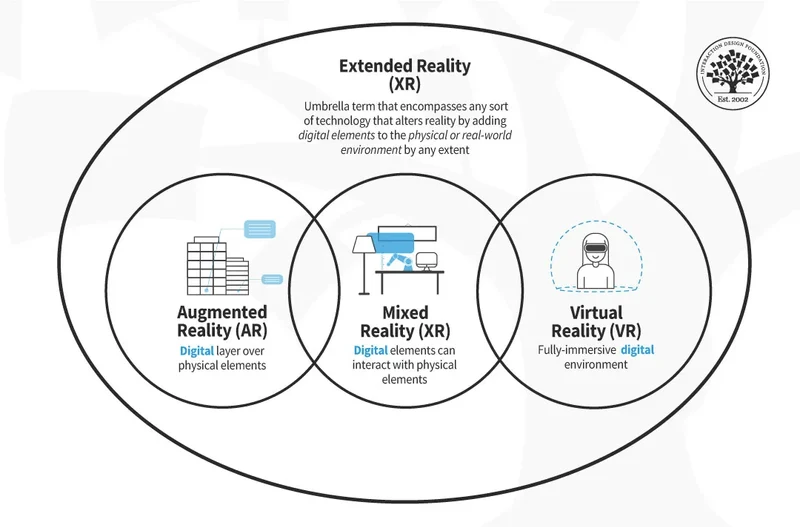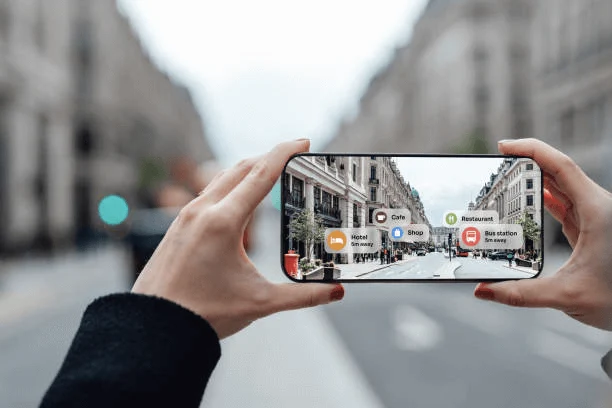Augmented Reality Companies That Are Empowering the Metaverse
Augmented reality (AR) is the experience of reality — quite literally — augmented by technology to superimpose images, sound, animation, and data that complement the real world.
Augmented reality as a concept was referred to as early as 1901, though the exact term came only later. Thomas Caudell, a former Boeing researcher, is credited with coining the term augmented reality. In his paper on the topic, he referred to the heads-up display (HUD) that aircraft manufacturers use in the incredibly complex manufacturing process.
The AR market is projected to grow sixteen-fold from USD 6.12 billion in 2021 to USD 97.76 billion in 2028 at a CAGR of 48.6%. Shopify also found that retailers that turned to AR to do virtual try-ons during the pandemic experienced a 94% increase in conversion compared to retailers that did not.
Is AR the future? In this article, we’ll talk about some companies that are making massive headway toward the metaverse.
How Does AR Differ from Mixed Reality (MR), Virtual Reality (VR), and Extended Reality (XR)?

In augmented reality, a user views their real-world environment through a device, with the added data overlaid over it. A “magic window” (usually a smartphone) allows users to view 360 content without the use of an AR headset.
Commercial examples include:
Stargazing apps like Star Walk 2 overlay information about constellations in the night sky for edutainment.
- Google Translate camera translates text in real-time into an image.
- The wildly popular Pokémon GO by Niantic.
- The now commercially discontinued Google Glass in a headset form.
- Furniture companies like IKEA and Wayfair use AR so users can visualize items in their homes before purchase.
- Even Instagram filters are a form of augmented reality.
- Walmart, Gap, ASOS, and Adidas are among some of the retailers that offer a virtual fitting room to try on glasses or clothes.
- As early as 1988, General Motors began installing head-up displays in their car models, and now you can get a head-up display for as little as $34.
Industry Uses of Augmented Reality
Healthcare
One of the first commercial uses of augmented reality was in supporting surgical procedures. Today, it is used for identifying veins to draw blood from, removal of spinal tumors, and even treatment of phobias.
Manufacturing
Automobiles and aircraft are incredibly complex. It takes 6 million parts to build a Boeing 747-8, and often parts need to be placed within millimeters for it to function correctly. With the help of AR, the risk of human error and the number of hours required for specialized training decreases dramatically.
Oil & Gas Offshore Training
On offshore rigs, training is vital to survival and avoiding accidents. One such company, Saudi Aramco, has recorded a 70% increase in safety compliance, as well as a 10% improvement in workforce productivity. General Electric is equipping their field engineers with smart helmets that allow them to be assisted in real-time by their colleagues with access to documents and procedures.
Military
AR is helpful for the military for technology-assisted operations. The first application of AR was for head-up displays for fighter pilots.

Virtual reality, on the other end of the spectrum, completely replaces a user’s real-world environment with a simulated one. For this to be immersive, VR headsets usually displace a user’s sight and hearing with the virtual world. Users sometimes hold controllers that allow them to explore their virtual environment with their hands. The discontinued Google Cardboard is an example of a VR headset. You’ve probably heard of others like HTC Vive and the Oculus Quest on the market.
In mixed reality, digital elements are not just overlaid over the real-world environment, but they are interacting with physical elements in the real world. In this way, mixed reality is a hybrid of augmented and virtual reality where digital and physical objects co-exist and interact in real time.
Extended reality is a term that encompasses AR, XR, and VR. These technologies extend our reality and constitute a big part of the metaverse experience, such as the one Accenture is building.
What Technologies Are Behind Augmented Reality?
Here’s a quick and dirty laundry list of tech terms that are used in the creation of augmented reality.
Software
- Simultaneous Localization and Mapping (SLAM) allows apps to understand 3D objects and scenes. It allows tracking of the user relative to the physical world and allows images to be overlaid.
- Depth tracking: Chances are you have a light detection and ranging (LiDAR) sensor within your smartphone. It bounces light waves at surfaces and measures the reaction time to determine the shape and distance of objects in the area. This is crucial for apps to understand the physical world
- Image processing: GPUs or CPUs do the heavy lifting of processing and rendering images.
Hardware
- Camera
- Sensors
- A display/projector
- Gyroscope
- Accelerometer
- Global Positioning System (GPS)
- Solid state compasses
- An input device, like a touchscreen
- An output device, like a projector or screen
Which Companies Are Enabling The Metaverse?
Unity
The dominant software framework for augmented reality in the market today is Unity. Users can create and operate interactive, real-time 3D (RT3D) content on Unity. As of 2021, 60% of AR/VR content is powered by Unity. Unity also powers 90% of head-worn AR experiences. Their enterprise clients include many companies in the automotive industry for manufacturing, maintenance, and even marketing!
NVIDIA
Powering any AR or VR experience requires the use of Graphics Processing Units (GPUs). This requires a tremendous amount of processing power, more than traditional CPUs (Central Processing Units) can handle. NVIDIA designs and manufactures the best-performing GPU in the market: the Nvidia GeForce RTX 3090 TI, along with other discrete graphics cards. NVIDIA has set a market standard in its usage of VR headsets.
On streaming solutions, the CloudXR is NVIDIA’s solution for streaming AR and VR experiences from a remote server. They have enabled businesses like SAP and Autodesk with this solution as well.
Back in 2013, Google pioneered the first commercially available AR headset called the Google Glass. On the back of ethical concerns and low consumer uptake, Google took them off the market in 2014 and they’re now only available for enterprise customers. More recently, Google Maps has rolled out navigation within indoor spaces using AR markers and directions.
Google also offers its SDK called ARCore which is powering experiences within Snapchat and TikTok. Other AR initiatives include Google Lens (powering Google camera Translate), AR in Google Search, and Live View in Google Maps.
Snap
Snap’s lenses are incredibly popular in the retail space. Retailers can create virtual try-on experiences with Lens Studio, Snap’s AR developer toolkit. There are over 500 million monthly active users of Lenses according to Snap. With Custom Landmarkers, third parties can tie their Snapchat lenses to specific real-world locations.
Snap has also developed smart glasses, Spectacles, which largely avoids the pitfalls of Google Glass by being more affordable and featuring a prominent red light to let other people know that the Spectacles are recording. They’re only available to developers at the moment, but exciting collaborations are already emerging.
Wikitude
Wikitude had its beginnings in the Wikitude World Browser App in 2008. The app showed users all the sights, restaurants, accommodations, and current events nearby — together with additional information like distance, opening hours, rating, and contact details. Currently, Wikitude is providing users with Wikitude Software Development Kit (SDK), an AR development toolkit that is powering experiences for BP, Disney, and The Washington Post.
How Do I Know if AR is Right For My Business?
You can use the Search for vendors function on our site, where you can find companies like Codeus and Web Factory that have expertise in AR. Spoilt for choice? Write to us with your requirements and we will give you customized recommendations, for free, within 72 hours.
FAQs:
Q1. What is the difference between augmented and virtual reality?
AR is a digital experience where data is overlaid over the user’s real-world environment. This information does not interact with visible physical objects in the real world. Usually, augmented reality is experienced through a “magic window”, like your smartphone screen for example.
Virtual reality on the other hand displaces users from their real-world environment into a completely new, computer-generated 3D environment with the use of a headset and console.
Q2. What AR company is working with Apple?
In a note to investors in mid-2021, Genius, a supplier for iPhone lenses is mentioned. Genius is a supplier for Meta’s Oculus Quest 3 Headset and is expected to supply lenses for Apple’s AR headset. Apple has also made a series of augmented reality acquisitions since 2015, like Akonia Holographics, Metaio Creator, and PrimeSense.
Q3. Why is AR not popular?
The technology is poorly understood, it’s still too expensive, and headsets are bulky.
When Google Glass launched in 2013, the term Glasshole was used to describe an individual who behaved inappropriately while using the Google Glass interface. Many people surfaced ethical concerns about being filmed unknowingly, and about the social isolation that may arise from using tech excessively.
Another factor was accessibility — Google Glass sold for USD 1,500, and the enterprise Microsoft Hololens model begins at 3,500. Extended reality experiences require a heavy amount of processing power, and GPUs are not cheap.
Bulky headsets are not suitable for everyday use, which is probably why AR headsets have been more popular with enterprise customers for the time being.
With the aid of the Internet of Things (IoT) and machine learning, AR can become more accurate, effective, and accessible.
